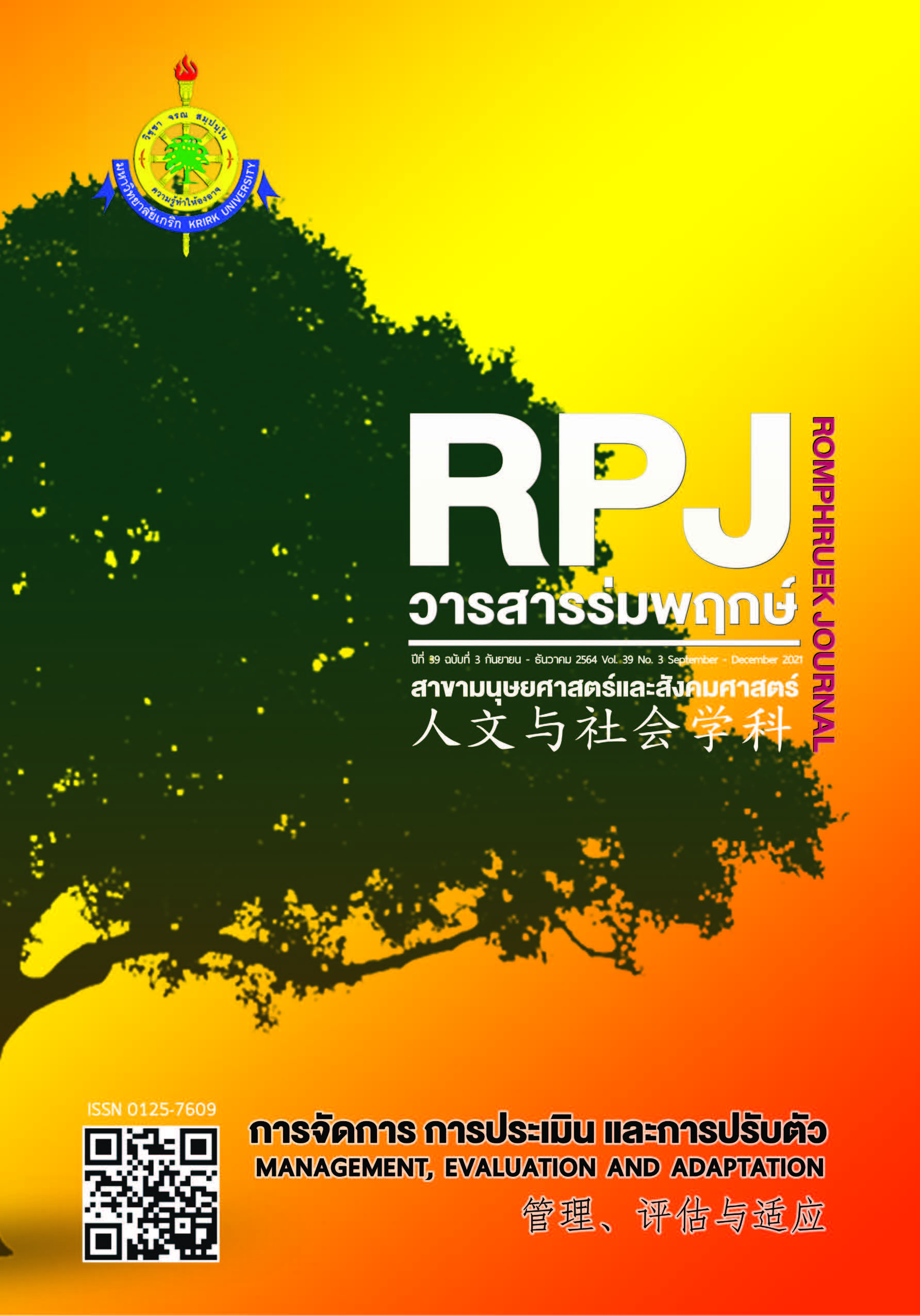Effectiveness of Village Health Volunteer’s Competency Development Program for Stroke Prevention Among Hypertensive Patients in Sa Pradu Subdistrict Wichian Buri District Phetchabun Province
Main Article Content
Abstract
This quasi-experimental research aims to study investigate effectiveness of village health volunteer’s competency development program for stroke prevention among hypertensive patients. It was used the one group pretest posttest design. Purposive sampling technique was applied to select 40 willing village health volunteers in the Subdistrict Administrative Organization in Sa Pradu sub-district, Wichian Buri district, Petchabun province. Bandura’s Self-Efficacy theory is applied was used as a conceptual framework in this study. The experimental group was required to complete 8 activitiesfor 10 weeks include health education, video media, games, modeling, group activities, simulations, role-playing, demonstrations, practices, and home visits. Questionnaires were distributed to collect data before and after the participants joined the program which were developed by the researcher. Content validity of questionnaires was verified by the 5 experts. The reliability of the second part using the Kuder-Richardson formulas yielded the coefficients of 0.72 (KR-20) andthe third part using the Conbach’s Alpha Coefficient of0.82. Data analysis was made for percentage, mean, standard deviation, paired-samples t-test. The results showed that after the program, the experimental group hadknowledge about hypertension and strokes, self-perception, and skills of care to advise hypertensive patients for stroke prevention higher than that before the experiment by a statistically significant at p<0.05.
Article Details
Every article published in the Romphruek Journal of the Humanities and Social Sciences is the opinion and point of view of the authors. Thery're not the viewpoint of Krirk University or the editored department. Any part or all of the articles for pablication must be clearly cited.
References
กมลทิพย์ ทิพย์สังวาล และคณะ. (2561). ผลของโปรแกรมการพัฒนาสมรรถนะอาสาสมัครสาธารณสุขประจำหมู่บ้านดูแลผู้สูงอายุในชุมชน. วารสารมนุษยศาสตร์และสังคมศาสตร์ บัณฑิตวิทยาลัย มหาวิทยาลัยราชภัฏพิบูลสงคราม,12(1), 275-291.
กองสนับสนุนภาคประชาชน กรมสนับสนุนบริการสุขภาพ กระทรวงสาธารณสุข. (2556). คู่มือ อสม. มืออาชีพ. (พิมพ์ครั้งที่ 1). กรุงเทพฯ : โรงพิมพ์พระพุทธศาสนาแห่งชาติ.
กองโรคไม่ติดต่อ กรมควบคุมโรค. (2562). รายงานสถานการณ์โรคNCDs เบาหวาน ความดันโลหิตสูงและปัจจัยเสี่ยงที่เกี่ยวข้อง. (23 มิถุนายน 2563) สืบค้นจาก http://www.thaincd.com/2016/media-detail.php?id=13865&tid=&gid=1-015-005.
กลุ่มงานเวชระเบียน. (2563). รายงานโรคความดันโลหิตสูงและโรคหลอดเลือดสมองประจำปี พ.ศ. 2561-2563. เพชรบูรณ์ : กลุ่มเทคโนโลยีสารสนเทศโรงพยาบาลวิเชียรบุรี.
กิรณานันท์ สนธิธรรม และ สมเสาวนุช จมูศรี. (2563). ผลของโปรแกรมการส่งเสริมการรับรู้สมรรถนะแห่งตนต่อการดูแลกลุ่มเสี่ยงก่อนความดันโลหิตสูงของอาสาสมัครสาธารณสุขประจำหมู่บ้าน. วารสารพยาบาลทหารบก, 21(2), 102-110.
จอม สุวรรณโณ และคณะ. (2561). Cardiovascular Risk Factors in Young Adult Patients with Acute Ischemic Stroke. วารสารสมาคมโรคหลอดเลือดสมองไทย, 17(2), 5-16 .
จิรัชยาสุวินทรากร และคณะ. (2562). ผลของโปรแกรมการส่งเสริมการรับรู้ความสามารถของตนเองของอาสาสมัคร สาธารณสุขในการเฝ้าระวังและป้องกันโรคหลอดเลือดสมอง. วารสารพยาบาล, 68(1), 39-48.
นวพร วุฒิธรรม และคณะ. (2563). ผลของการสร้างเสริมการรับรู้สมรรถนะแห่งตนต่อการควบคุมระดับความดันโลหิตในกลุ่มเสี่ยงโรคความดันโลหิตสูง. วารสารพยาบาลทหารบก, 21(1), 310-318.
ปาณิสรา ส่งวัฒนายุทธ และ จินต์ทิพา ศิริกุลวิวัฒน์. (2562). การส่งเสริมสุขภาพโดยการเล่าเรื่องในผู้ป่วยความดันโลหิตสูง. วารสาร พยาบาลหทารบก, 20(3), 72-78.
พันทิพพา บุญเศษ และ ลัฆวี ปิยะบัณฑิตกุล. (2561). ผลของโปรแกรมการป้องกันโรคหลอดเลือดสมองในกลุ่มเสี่ยงสูง ตำบลห้วยบง อำเภอเมือง จังหวัดชัยภูมิ. วารสารโรงพยาบาลสกลนคร, 21(2), 28-41.
ภาสิต ศิริเทศ และ ณพวิทย์ ธรรมสีหา. (2562). ทฤษฎีการรับรู้ความสามารถของตนเองกับพฤติกรรมการดูแลสุขภาพของผู้สูงอายุ .วารสารพยาบาลทหารบก, 20(2), 58-65.
Bandura, A. (1986). Social foundation of thought and action : a social cognitive theory. Englewood Cliffs, N.J : Prentice-Hall.
Bandura, A. (1997). Self–efficacy : The exercise of control. New York : Freeman and Company.
Bloom. (1971). Hand book on Formative and Summative Evaluation of Student Learning. New York : Mc Graw-Hill Book Company.
Cronbach, L.J. (1951). Coefficient alpha and the internal structure of test. Psychometrika, 16(3), 297-334.
Jerrold E., Kemp & Don C., Smelle. (1989). Planning, Producing, and Using Instructional. New York : Harper & Rownd.
Kuder-Richardson. (1993). การหาความเชื่อมั่นโดยใช้วิธีการของ Kuder-Richardson Method. (January 1, 2563) Retrieved from http://www.wijai48.com/leriability/richartson.htm.
Likert , Rensis. (1967). The Method of Constructing and Attitude Scale. New York : Wiley & Son.


